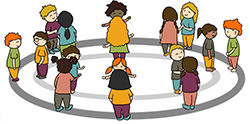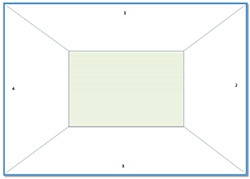Short Description
This lesson plan can be used in English with pupils in vocational or general programmes. It is especially relevant for pupils in Healthcare, childhood and youth development (HO) or Restaurant and food processing (RM) being a useful starting point for vocational/FYR related tasks within English.
The aim of the lesson plan is to use the film Pieces of April to provide pupils with an introduction to Thanksgiving in the USA. The film also provides a base for discussions centred around multiculturalism and family relationships, as well as a starting point for more detailed work on terminal illness if required. They will use three of the basic skills (grunnleggende ferdigheter): å kunne uttrykke seg muntlig, å kunne bruke digitalt verktøy og å kunne skrive.
Den generelle læreplan: Filmen dekkjer fleire tema som ein kan diskutere innanfor hovudområda: Det meiningssøkjande menneske, kulturarv og identitet (s. 2) og Det integrerte menneske (s. 8).
Competence Aims in K06
Engelsk
Muntlig kommunikasjon
- forstå og bruke et bredt generelt ordforråd og et faglig ordforråd knyttet til eget utdanningsprogram
- lytte til og forstå sosiale og geografiske varianter av engelsk fra autentiske situasjoner
- uttrykke seg på en nyansert og presis måte med god flyt og sammenheng, tilpasset formål og situasjon
Kultur, samfunn og litteratur
- drøfte engelskspråklige filmer og andre kulturuttrykk fra forskjellige medier
- drøfte kultur og samfunnsforhold i flere engelskspråklige land
Helse og Oppvekst vg1
Kommunikasjon og samhandling
- grunngi og vurdere eigne haldningar og veremåtar når omsorg og utvikling hos brukaren er målet, uavhengig av kultur, religion, livsførsel og funksjonsnivå hos den andre
- gjere greie for kva empati tyder innanfor oppvekst-, helse- og sosialsektoren
Restaurant og Matfag vg1
Kosthald og livsstil
- lage tradisjonsmatfrå ulike område i Noreg og mat frå ulike kulturar, og drøfte kva måltidet har å seie som kulturberar
Kokk og Servitør vg2
Servering, bransje og miljø
- gjøre rede for krav til helse, miljø og sikkerhet innen kokk- og servitørfag, og følge dem i praksis
Teaching Objectives
The pupils should be able to:
- provide a short succinct summary (oral or written) of why Americans celebrate Thanksgiving Day
- describe a typical Thanksgiving meal
- show a wider range of general and program related vocabulary
- show increased understanding of how illness and suffering can affect people (optional)
Debriefing and Assessment
- . If working on Google docs, then the groups could assess each other’s video presentations or texts. Provide them with an assessment form for written/oral assessment

An alternative for sharing is to use the programme Padlet where the class can create their own wall on the Internet.
- Summary. Ask them to form two circles - an inner circle facing outwards and an outer circle facing inwards. Ask the inner circle to tell the pupil they are facing in the outer circle, what Americans eat at Thanksgiving. The pupil in the outer circle should then reply by explaining why Americans celebrate thanksgiving. Teachers add more questions related to the film and the pupils in the outer circle take one step to the right in order to get a new communication partner.

Or - Use a consensus mat sheet and ask each person to write down the most important things they have learnt from watching the film, including words and terms, and then agree on what should be written in the centre box to be shared with the rest of the class. This is a good film to do this with, because there are lots of different themes.
- Self-assessment: Value line. Give the pupils a sheet of paper with a Continuum-Value line:

Ask the pupils to put a cross on the line (above) reflecting their opinion, and then ask them to stand and form themselves physically, in a line according to where they have placed their cross on the paper. Each pupil should then talk to the two pupils either side of them and give reasons for their choice. The line can be formed into a circle so that the pupil who feels that they learnt the least stands next to the pupil who feels that they learnt the most.
- Written work and video presentations can be handed in and assessed by the teacher too. The role-plays can be assessed by fellow pupils or the teacher.
Resources
Attachments:
- Sheet 1 - Themes and Kompetansemål (pdf)
- Sheet 2 - Plot summary (pdf)
- Sheet 3 - Characters and relationships (pdf)
- Sheet 4 - Food and traditions (pdf)
Links:
- History of Thanksgiving (history.com 2:40 min)
- 22 Easy-to-Make Thanksgiving Menus (Country Living)
- Cancer information (National Cancer Institute)
- Film trailer (YouTube 2:25)
- Film clip (part 1/8)
Preparations
Teacher
- Book auditorium or make sure computer, speakers and projector works
- Have film at hand
- Have discussion points on paper for the pupils to think about during the film
- Prepare posters and hang up in classroom
- Make a vocabulary list
Pupils
- Notebook, pen or penci
Plan of Lessons
Pre-film activity
Activate pupils’ previous knowledge. Have pairs, or give the different groups one question each to discuss certain themes to prepare them for the film. Possible themes include:
- Why do Americans celebrate Thanksgiving?
- What do they eat at Thanksgiving?
- How important is food in relation to cultural identity?
- How multicultural is the USA and New York?
Sum up with a class discussion.
Film: Pieces of April. Whilst-watching film activities
- Use one of the forms below, depending on which particular aspect of the film you wish the class to focus on:
- Characters and relationships (Sheet 3 - see Resources)
- Food and traditions (Sheet 4 - see Resources)
Post-film activities may include
- Film discussion
- Class discussion on character traits and a general discussion on themes, setting, plot, etc. Use pupils' notes from sheet 3 as a starting point.
- Thanksgiving Day (tasks can be adapted to language level)
- The teacher hangs various posters up with different dishes in a thanksgiving menu (see Resources: 22 Easy-to-Make Thanksgiving Menus). Divide the pupils between the posters and ask them to write up the ingredients on their particular poster. You could then rotate the groups around the posters and ask them to make any changes that they see fit. On the last poster they come to, the group has to write a recipe for that particular dish which should include a list of ingredients together with a set of instructions on how to make their dish. They can do this on google.doc or Word. A group spokesman can read out their instructions.
- Make a series of posters showing various thanksgiving dishes and ask pupils to place the correct name label on them. Or make a Kahoot, Quizlet etc. to practise voacabulary
- Role-play
- Each group has to act out making their dish to the rest of the class. They can pretend that they are on TV and role-play. This presents the possibilty of the group making a video on youtube (google.doc) or Screencast-o-matic.
- The group could do a restaurant role-play centred around Thanksgiving Day. They could for example make a thanksgiving menu.
- Class Discussion
- Watch the video clip from Pieces of April (about 3 minutes into the clip, see Resources) and ask your pupils to identify the culinary mistakes that April is making.
Follow-up
You could go on to look at other dishes associated with the USA and UK, or discuss multiculturalism in the USA and UK.
You could take a look at some terminally ill teenagers/adolescents who have become known internatioanally through their fund-rasing and raising-awareness activities.
Comments
This lesson plan is very flexible and can be used in all English lessons and is particulary relevant to RM and HO pupils.
Developed by
Alison Jones Rød, Fusa vidaregåande skule
Et FYR-opplegg, i samarbeid med Fremmedspråksenteret
